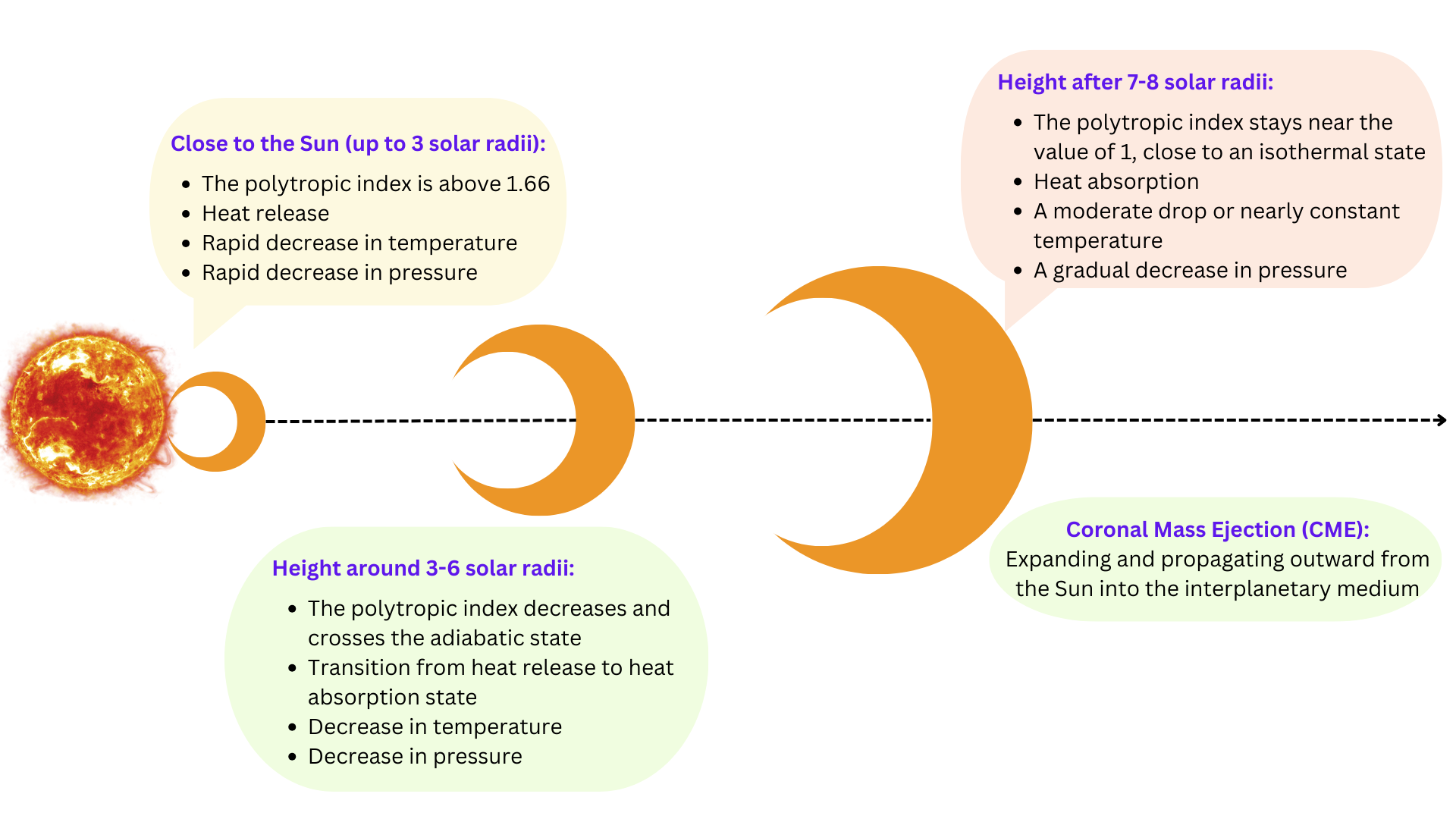A new model of the internal thermal evolution of Coronal Mass Ejections (CMEs), as they traveled from the Sun toward the Earth, has helped divulge the heat budget of the CMEs and their transactions during the dynamic evolution of CMEs. The study can help trace the thermal histories of solar CMEs and predict the impact of space weather on planets in our solar system.
CMEs are massive eruptions of plasma and magnetic fields from the Sun's outer atmosphere. If CMEs are Earth-directed, they can adversely affect our planet's space weather and space-based infrastructure. How hot a CME starts from the Sun and how it cools down while reaching Earth has yet to be understood.
Near-Sun spectroscopic observations (and near-Earth in-situ observations) carried out currently are not sufficient to understand the evolution of CMEs at intermediate/interplanetary distances between the Sun and Earth.
A team led by solar astrophysics at the Indian Institute of Astrophysics (IIA), Bengaluru, an autonomous institute of the Department of Science and Technology (DST) and their international collaborators have modelled the continuous thermodynamic evolution of CMEs which is critical for understanding the Sun-Earth connection. For this purpose, the kinematics of CMEs were used as inputs to the model.
"Beginning a novel trend of research, our study derived a comprehensive evolution profile of CME thermodynamic parameters leveraging the analytical called the Flux Rope Internal State (FRIS) model. The indigenously developed model takes inputs from the wide-field-of-view coronagraphic white-light observations,” said Soumyaranjan Khuntia, the lead author and a doctoral student at IIA. The research has applied the model to two specific CMEs that erupted from the Sun in the past and had data from multiple telescopes and spacecraft.
Utilizing data from the NASA & ESA space missions such as SOHO (SOlar and Heliospheric Observatory), STEREO (Solar TErrestrial RElation Observatory), SDO (Solar Dynamics Observatory) along with an indigenously developed analytical model, the team was able to establish a noteworthy fact about the differential heating in CMEs having different kinematics through the interplanetary space. During its early phase, marked by rapid deceleration, the fast CME was found to have released heat, whereas the slow CME, in its gradual acceleration phase, showed evidence of heat absorption. However, both the fast and slow CMEs exhibit heat-absorption tendencies in their later phases of expanding propagation away from the Sun, becoming more like they keep a steady temperature.
"The evolution in the heat budget observed in CMEs confirms a significant finding -- CMEs undergo processes involving the release or absorption of heat during their journey through the heliosphere,” said Dr. Wageesh Mishra, a faculty at IIA.
"Our findings also underscore the roles of distinct forces in CME expansion. Centrifugal and thermal pressure forces primarily contribute to the expansion of the CMEs, while the electromagnetic force (Lorentz force) prevents the expansion throughout. The slowest decreasing trend in thermal pressure force suggests its dominance towards the radial expansion at higher heights", he added.
"The study emphasizes the importance of comprehending the internal thermodynamic evolution of CMEs during their journey, a currently underexplored facet of space weather research, with the potential to substantially enhance our ability to predict CME characteristics. The capability to estimate the heat content of CMEs and their role in driving perturbations in Earth's magnetic field needs to be better understood. To mitigate the forecasted space weather impacts, we are further investigating if the thermal properties of CMEs could be used as markers for their potential to cause intense space weather phenomena," Khuntia pointed out.
Dr. Wageesh Mishra said, "We look forward to utilizing observations from the Visible Emission Line Coronagraph (VELC) onboard the recently launched Aditya-L1 mission, India's first space-based solar observatory, combined with our developed model, to understand CMEs at heights unattainable with existing coronagraphic observations".
This research has been accepted for publication in The Astrophysical Journal (ApJ) and is co-authored by Dr. Wageesh Mishra from IIA, Bengaluru, Dr. Sudheer K Mishra from Astronomical Observatory, Kyoto University, Japan, Dr. Yuming Wang & Shaoyu Lyu from CAS Key Laboratory of Geospace Environment, University of Science and Technology of China, People’s Republic of China and Dr. Jie Zhang from Department of Physics and Astronomy, George Mason University, USA.
Publication link: DOI: 10.3847/1538-4357/ad00ba

Fig – Briefly demonstrating the model-derived thermal evolution of Coronal Mass Ejections during their journey from the Sun.






























